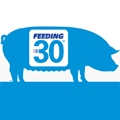 Second parity sows are prone to what’s often referred to as a “sophomore slump” in production. The stress of a gilt’s first litter can result in under-conditioning which can affect the length of time it takes for the sow to return to estrus. To prevent this lag time or a slump in future production, proper nutrition strategies are essential. Proper nutrition can also help to keep young sows in the herd longer.
Second parity sows are prone to what’s often referred to as a “sophomore slump” in production. The stress of a gilt’s first litter can result in under-conditioning which can affect the length of time it takes for the sow to return to estrus. To prevent this lag time or a slump in future production, proper nutrition strategies are essential. Proper nutrition can also help to keep young sows in the herd longer.
That’s according to Mike Hemann, Great Lakes Region swine nutritionist for Purina Animal Nutrition LLC. When working with swine producers, Hemann recommends creating sow rations and/or feeding strategies based on parity levels. If managing in groups, young gilts should be separated from older sows and fed accordingly when possible. From his experience, producers that thrive have a balance of age and parity structure in their facilities.

“Profitability and overall success comes down to having a good parity structure within your sow herd,” he says. “The third parity is often your breakeven point so, after the second parity, the sow becomes profitable for the producer. It’s important to not have too many young gilts nor too many old sows in the herd to keep that balance between current profit and future profit potential.”
The herd should then be grouped and fed based on sow age and individual animal nutrient requirements based on a consistent and routine body condition scoring system. To prevent early burnout, younger gilts – or parity 1 (P1) females – should be fed nutrient-dense rations or provided with a top-dress when facility design challenges allow the producer to only feed one lactation ration.
“P1 females require rations with a higher energy level and amino acid profile because they are limited on physical capacity for intake,” Hemann says. “When we get to an older group where the sows have a physical capacity for higher intake, we can drop those ration requirements to accommodate those higher intake-type sows.”
Feeding nutrient-dense rations to the younger sows helps accommodate nutrient demands and can keep the sows in better body condition during their first parity. Hemann says that proper P1 nutrition helps sows transition into the second parity and sets the gilts up for her profitability stage.
“If we bring in properly conditioned gilts and feed them accordingly during the first parity, we can decrease the ‘sophomore slump’,” he says of the common lag seen in P2 sows. “Transitioning P1 gilts in good body condition allows us to bring them back as P2 sows that have the potential to produce a good amount of high-quality pigs in their second litter. Properly managed young sows also provide a base for future longevity in the herd.
“The sows then become profitable in their third parity,” he adds. “If we feed our young sows correctly, we’ll have the table set for profitable production in that third parity and beyond.”
August 14, 2012 - Feeding for 30


